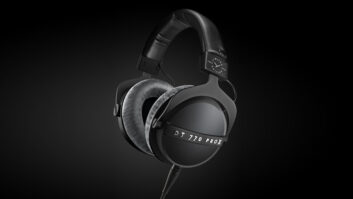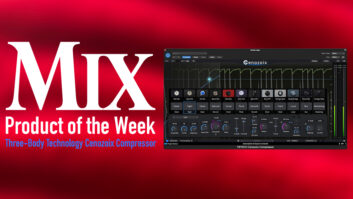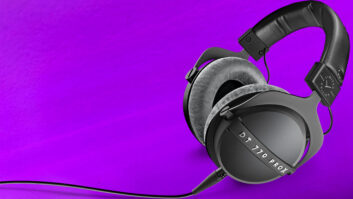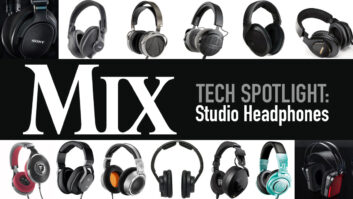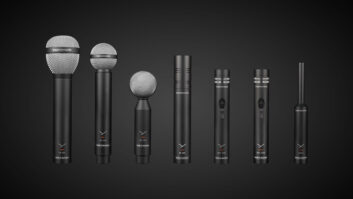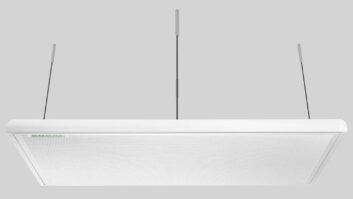
The base unit doubles as a stereo headphone amp.
Offering a solution for monitoring and mixing 5.1 surround audio using standard-technology headphones is beyerdynamic’s (www.beyerdynamic.com) Headzone, which will be unveiled at this month’s AES show in San Francisco (Booth #1102). Touted as the “first portable 5.1 control room,” the system comprises a half-rack headphone amplifier/DSP processor and DT 880 PRO HT headphones, a modified pair of the company’s popular DT 880 PRO reference headphones.
“In a good studio, you have good localization in terms of a frontal plane and well-defined spacing on the speakers, and we’re re-creating this sonic localization using headphones,” says Paul Froula, beyerdynamic’s pro audio business manager. “Headzone’s portability offers an affordable and flexible alternative for audio engineers to mix surround sound.”
Unlike other systems that do surround simulations using headphones, the impetus behind Headzone was creating a convincing and realistic model of the parameters in an ideal auditory space based on 5.1 speaker playbacks. Users simply connect their surround channels (L/C/R/Rs/Ls and, optionally, LFE) using six analog RCA jacks or a FireWire digital connection to the desktop base station, plug in the headphones and start working. A rear panel switch adjusts the operation for either -10dBV or +4dBu inputs. From there, Headzone’s onboard Binaural Environment Modeling DSP processes the audio channels so they are heard in the headphones as they’d be perceived in an actual room environment with a realistic “outside the head” sound impression, calculating the reflections and loudspeaker placements to create the ideal room for listening to surround mixes.

DT 880 PRO HT headphones
Taking the system a step further is a new patented technology that continuously tracks the listener’s head position in the room and adjusts the audio reproduction accordingly. “With this Head- tracking feature, the two little Jetsons-type devices on top of the DT 880 PRO HTs transmit ultrasonic frequencies to the receiver to calculate the distance and positioning of your head,” Froula explains. “If you turn your head to the right, the left earpiece will play the center and your right ear will be hearing the rears. It tracks the position of your head as if you were in the acoustical space.” A device within the base station constantly monitors the incoming pulses from the head tracker. The arrival times from each side of the head tracker are compared and the system measures any delay differences between the two signals. Once a delay between left and right sides is detected, the rotation angle is calculated and DSP is applied to match the apparent head positioning. Everything occurs smoothly — in real time — so to users, the effect is transparent and they experience what would happen naturally.
The Headtracker connection uses a multipin connector that’s separate from the standard ¼-inch TRS audio jack. This allows the ‘phones to be used for standard stereo listening on any other system, but the Headzone base unit can also be used with headphones that do not have the Headtracker installed. In such cases, the system still provides a surround sound experience, but without the Headtracker functions. A front panel bypass control can switch the system from its Binaural Environment Modeling processing to act as a conventional, reference-quality stereo headphone amplifier.
In addition to acting as a multichannel digital input, Headzone’s IEEE-1394 FireWire connection serves as the connection for using a PC (Windows 2000 or XP) or Mac (OS X) to tweak DSP parameters and store presets of favorite settings. The included Headzone Controller software provides interactive options for “modeling” this room. Unlike reverberation devices, which simulate the reverberant characteristics of a certain room, Headzone lets users custom-design the characteristics of a loudspeaker system in any control room with just a few mouse clicks. Among the available parameters are ambience level (essentially wet/dry-style adjustment), room size and positioning. The latter is a control for adjusting the virtual distance between the listener and the “speakers.” The software is Apple Core Audio — compliant and ships with WDM and ASIO drivers. At press time, beyerdynamic was developing a Universal version of the software for use with Apple’s new Intel-based Macs.
The software also includes some simple virtual bass management in the software that defeats the LFE input, instead routing sub bass from the front L/R speakers to the overall headphone mix.
Besides its obvious uses in situations such as broadcast vehicles where space and SPL restrictions can create a difficult or impossible surround monitoring environment, Headzone is well-suited for editing suites and game development/design programming, as well as portable applications such as laptop production. In the consumer sector, Headzone’s “silent listening” should appeal to late-night surround fans who don’t want to disturb the neighbors or wake the kids. But for most pro audio engineers and producers, Headzone might provide an easily transportable personal reference system for surround mixing, used either alone or with studio mains or near-field speaker systems.
But the key point is, how does it sound? “It creates an incredibly realistic scenario if you’re doing broadcast and don’t have room for a 5.1 system in your truck,” says Froula. “I was skeptical about this at first, but when I used it on several surround mixes, I was impressed.” For the rest of us, we can listen firsthand and decide for ourselves when the system debuts at AES.


